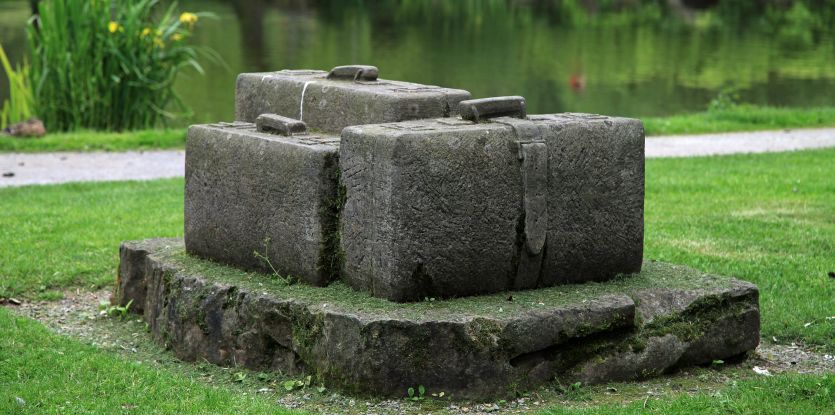“One should live with the times,” said Chassidic master Rabbi Schneur Zalman of Liadi to his disciples, and explained his meaning: a person should derive guidance and inspiration from the weekly Torah reading.
Every week, another parashah (“chapter” or “section”) of the Torah is publicly read in the synagogue[1] in an annual cycle which is completed on the festival of “Simchat Torah.” The weekly parashah, Rabbi Schneur Zalman was saying, is the soul of the week in which it is read, the spiritual warp and woof of its time-weave. By following the parashah’s dictates and directives, we attune our lives to the inner essence of the particular stretch of time in which we find ourselves.
“Living with the times” assumes an added dimension when two parashiyot are joined to form a single reading. Because the number of Shabbat readings varies from year to year,[2] there are eight such potential “pairs” among the Torah’s 54 parashiyot. This creates a situation in which the different – and at times, even conflicting-lessons of two parashiyot combine into a unified “directive of the week” for their joint week.[3]
In addition, the weekly parashah bears an integral relationship with the other time-landmarks with which it intersects. The fact that a parashah is read in a certain month, or in proximity to a certain festival, imparts a distinct context and an additional facet to the lessons with which it instructs our “living with the times.”[4]
By way of example, we might look at two contiguous parshiot – Mattot (Numbers 30-32) and Massei (Numbers 33-36). Let us examine their individual lessons, but also note that, in certain years, they combine to form a single reading and jointly instruct a single week. Let us also note that these two parashiyot are always read during the “Three Weeks” – the 21-day period from Tammuz 17 to Av 9 when we mourn the destruction of the Holy Temple and the onset of the centuries-long galut (exile and spiritual displacement) from which we have yet to emerge.
Two States of the Jew
Hardness is one of those qualities which we are forever seeking to acquire and rid ourselves of at the same time. There is more than a hint of condemnation when we describe a particular individual as a “tough” person, but no small measure of admiration as well. We denounce, in ourselves and others, behavior that is “obstinate” and “unyielding,” but also agree on how important it is to have the “backbone” to stand one’s ground and not be swayed from one’s principles.
Indeed, our journey through life requires firmness as well as flexibility, hardiness as well as pliancy. There are times and situations which necessitate, as our sages put it, to “be yielding as a reed, not hard as a cedar”;[5] yet there are also times and situations when we are called upon to employ every iota of obstinacy and “stiff-neckedness” we can muster to resist all that threatens our integrity and seeks to deter us from our mission in life. In the words of Chassidic master Rabbi Bunim of Pshis’cha:
“A person should have two pockets in his coat. In one pocket he should keep the verse, ‘I am but dust and ashes.’[6] His second pocket should contain the Talmudic saying, ‘A person is commanded to say: For my sake was the world created.’[7]“
This dual approach to life is implied in the Torah’s two names for the tribes of Israel. While the people of Israel constitute one entity as G-d’s “singular nation,”[8] they are comprised of twelve distinct tribes, each of which contributes its unique character and capabilities to our national mission.[9] Thus, the Torah refers to Israel’s tribes as shevatim, “branches,” or mattot, “rods,” expressing the concept that they are offshoots from a common stem, distinct from each other yet parts of a greater whole.
While shevet and matteh are both synonyms for “branch,” the shevet is a pliant, flexible bough, while matteh connotes a stiff stick or rod. Therein lies the deeper significance of these two names for the tribes of Israel: on certain occasions the Torah refers to us as “branches,” stressing the need for flexibility and tractability in life. In other contexts we are called “rods,” underscoring the need for firmness and determination in carrying out our mission as “a holy people”[10] and “a light unto the nations.”[11]
The latter point is the lesson of the parashah of Mattot, which opens with the verse, “And Moses spoke to the heads of the tribes….” Here, the tribes are called by the name “mattot” – a designation which becomes the name of the parashah and the crux[12] of its message: that there are times in the history of a people when they must employ the fortitude and fixity of the rod, when they must find the inner resolve to “stick it out” in a hostile and capricious world.
The Staff of Exile
“Hardness” is an acquired, rather than an intrinsic, state. While the potential for hardness always exists, it is actualized when a substance is subjected to galvanizing conditions and influences.
This can be seen in the shevet/matteh model. As a branch, the shevet is supple and yielding, bending to the wind and to every pressing hand. But when it is disconnected from the tree to face the elements as a lone, rootless rod, it stiffens into a matteh.
In other words, a matteh is a shevet hardened by the experience of galut. Deprived of tenderizing moisture from its nurturing roots, the latent hardness of the wood asserts itself, transforming the pliant branch into a rigid staff.
Therein lies the connection between the parashah of Mattot and the time of year in which it is read. During the Three Weeks, we mourn our exile from our homeland and the removal of G-d’s open presence in our lives as it was revealed in the Holy Temple in Jerusalem. We remember how the shevatim of Israel – a people anchored to their roots, vitalized by an undisrupted flow of spiritual nurture through their limbs – were torn from their tree to become a nation of homeless mattot.
But even as the Torah commands us to mourn the events of the Three Weeks, it insists that our mourning be a constructive endeavor, an opportunity to focus on how our state of exile might be exploited to a positive end. Even as we agonize over the rootlessness of galut, we must take advantage of the manner in which our disconnection from our natural environment strengthens us and galvanizes us. Even as we weep over the destruction of G-d’s home and the absence of His revealed presence in our lives, we must tap the tremendous reserves of faith and fortitude evoked by the challenges of an alien society and environment – reserves which would not been actualized were we to have remained a nation of shevatim undisturbed from their stem.
Forty-Two Journeys
But there is more to galut than the toughening of the Jewish soul. Galut is also a journey. A journey is not just a departure from home – it is an advance toward a destination. Therein lies the difference between a wanderer and a journeyer. The wanderer is escaping or being driven away from some place, while the journeyer is going to someplace. The wanderer is defined by where he is not, by the state and experience of homelessness and what this does to his inner self; the journeyer is defined by the place or places to which he goes and what he achieves there. When the wanderer and the journeyer return home, the wanderer brings back his “hardened” and matured self, while the journeyer brings the treasures procured at the various points of his itinerary.
What are we seeking in our places of exile? What do we bring home with us when we return from our journey to the ends of earth? The Talmud defines the purpose of galut as the acquisition of “converts.” “The people of Israel were exiled amongst the nations,” it declares, “only so that converts might be added to them.”[13]
These “converts” assume many forms. There are the literal converts – non-Jews who were included in the community of Israel as the result of our contact with the peoples of the world. More significantly (since the Torah neither instructs nor encourages us to seek converts to Judaism), there is the more subtle conversion of a pagan world to the monotheistic ethos and ideals of Torah, achieved by our 2000-year sojourn amongst the nations of the world.[14] The Kabbalists explain that the “converts” gained in the course of our galut are not only of the human sort, but also include the souls of all creatures and creations with which we have come in contact in the course of our dispersion to all corners of the globe. For every created entity has at its core a “spark of holiness,” a pinpoint of divinity that constitutes its “soul” – its function within G-d’s overall purpose for creation. Every time we utilize something – a physical object or force, an idea, a cultural phenomenon – to serve the Creator, we penetrate its shell of mundanity and realize its divine essence. This, the Talmud is saying, is the purpose of our galut: to redeem the sparks of holiness which lie buried in the most far-flung places and circumstances.
This concept of galut is expressed by the second parashah of our pair, the section of Massei (“journeys”), which chronicles the travels and encampments of the people of Israel in the Sinai desert. The parashah’s name derives from its opening verses: “These are the journeys of the children of Israel, who went out from the land of Egypt…. And they journeyed from Raamses … and they camped at Sukkot. They journeyed from Sukkot, and camped at Eitam….” Massei goes on to list the 42 journeys which comprised Israel’s travels from Egypt to Mount Sinai to the Holy Land.
The commentaries explain that these “journeys” are the forerunners and prototypes for the historical saga of Israel, as we advance through “the desert of the nations”[15] (as the prophet Ezekiel refers to the galut) to our ultimate “entry into the Land” in the age of Moshiach.[16]
It is significant that the Torah refers to our ancestors’ travels as “journeys” in the plural – a plurality that is preserved in the name of the parashah. If the purpose of galut were to lie solely in its rootlessness and what this brings out in the Jewish soul, then it should be defined as a “wandering” rather than a “journey”; and if its purpose were to lie exclusively in its ultimate “entry into the Holy Land” at galut’s end, then our sojourn in the “desert of the nations” should be regarded as a single journey, not a series of journeys. The fact that the Torah considers galut to be Massei, “journeys,” means that the purpose of galut is to be found also, and primarily, in the places to which it brings us, so that each of its travels is a journey and each of its “encampments” is a destination.
Integration
Both Mattot and Massei are parashiyot read during the Three Weeks – both are lessons on galut. On the face of it, however, they seem to be different, even conflicting, insights into the nature and purpose of our exile. Mattot instructs us on how the purpose of galut is to evoke in us the steadfastness and immobility of the branch-turned-rod. Massei, on the other hand, regards galut as a journey – as movement, change and transformation.
Indeed, we know that virtually everything in our existence is multifaceted, and that “life” is the endeavor to navigate, rather than to eliminate, its paradoxes. If “sticking to your principles” and “changing the world” seem conflicting goals, so be it; we nevertheless pursue them both, exercising our judgment and sensitivity as to which of these objectives should be emphasized in a given circumstance. So one week we dwell on the Mattot aspect of galut, regarding the challenges of its alien environment as something to resist and repel – thereby strengthening our resistance and hardening our inner resolve; and the next week we focus on the Massei approach to exile, exploring the ways in which our interaction with our galut environment serves to elevate it and transform it into a holier and more G-dly place.
But what happens when Mattot and Massei unite into a single Torah-reading? Then the “directive of the week” is to integrate them both into a single approach to galut. “Living with the times” in such a week means discovering how your interaction with a hostile environment is not a challenge to your values and convictions, but their strengthening and their affirmation. It means discovering how your “toughness” and intractability in your faith is not a hindrance to achievement and creativity, but actually an aid in your endeavor to transform the corner of the world to which you have been dispatched on the mission to build a home for G-d.
Based on the Rebbe’s talks on Shabbat Matot-Massei in the years 5729 (1969), 5733 (1973), 5735 (1975) and 5746 (1986), and on other occasions[17]
Adapted from the teachings of the Rebbe by Yanki Tauber
[1] The weekly parashah is read in full on Shabbat morning, and in part on Mondays, Thursdays and (the previous) Shabbat afternoon. An old Chassidic custom, publicized and propagated by the previous Lubavitcher Rebbe, Rabbi Yosef Yitzchak Shneerson (1880-1950), is to study a part of the weekly parashah, together with Rashi’s commentary, each day, so that one completes the entire parashah in the course of the week.
[2] The Jewish calendar year varies in length from as few as 353 to as many as 385 days (see Jewish Time, WIR, vol. X, no. 25). Furthermore, when Shabbat coincides with a festival, the festival reading, rather than the weekly parashah, is read. So depending on the length of the year and the arrangement of its festival days vis-a-vis the days of the week, a year may contain anywhere from 46 to 54 readings in its annual Torah-reading cycle.
[3] Each parshah is divided into seven readings (aliyot), for the seven individuals who are called up to read from the Torah. On those weeks when a joint parshah is read, the fourth aliyah begins in the first parshah and ends in the second; emphasizing the fact that the two parshiot now constitute a single parshah.
[4] See Shaloh, introduction to Parashat Vayeishev.
[5] Talmud, Taanit 20b.
[6] Genesis 18:17.
[7] Talmud, Sanhedrin 37a.
[8] Ibid., Berachot 6a.
[9] See A Home for Twelve, WIR, vol. X, no. 26.
[10] Exodus 19:6.
[11] Isaiah 42:6.
[12] The name of a thing being the sum of its essence – see The Gap (WIR, vol. X, no. 39) and sources cited there.
[13] Talmud, Pesachim 87b.
[14] “Moses bequeathed the Torah and the mitzvot only to the people of Israel … and to whoever desires to convert from the other nations … but one who does not desire to do so is not compelled to accept the Torah and mitzvot. In addition, Moses commanded, in the name of G-d, to compel all inhabitants of the world to accept the mitzvot commanded to the children of Noah” (Mishneh Torah, Laws of Kings 8:10). The universal Noachide mitzvot are: belief in G-d; prohibitions against murder, theft, adultery and incest, blasphemy, and cruelty to animals; and the establishment of a legal and social justice system.
[15] Ezekiel 20:35.
[16] Rabbeinu Bechayei and Ohr HaChaim on Numbers 33:1.
[17] Likkutei Sichot, vol. XVIII, pp. 378ff; ibid., vol. XXVIII, pp. 279ff.; et al.








As each of us continues in our pilgrimage on this earth may we pray to know when to be stiff and when to be supple and all for the sake of participating in the transformation of this earth in concert with the grace of the living G-d….for the kingdom of G-d forever will come and all of us who wish to see the face of G-d will see…and be forever joyful.
Thank you Rabbi.
In the Nicomachean Ethics Aristotle writes, hard is the good. Accurately or not, I take this to mean that goodness in self, family, community and world is difficult to achieve; and once it is achieved it is equally difficult to break.